

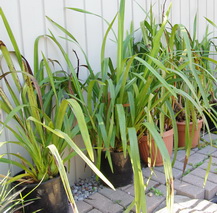
We are in the weeks between. The early vegetables are in the garden and we wait for the warm soil for the tender ones. That certainly doesn’t mean that we are short of gardening activities. Last weekend brought the deep freeze and overnight frost that we always allow for but hope never to see. I can now pretend that my planting procrastination was actually good planning. The weather now has me moving all kinds of things. The Cymbidium Orchids, that really don’t mind a bit of cool weather have found their summer home along the south side of the house. They will get lots of sun and frequent watering and fertilizing there. They will never approach attractive but they will grow and eventually develop next winter’s flower buds. The Oncidium and the Phalaenopsis, (when it’s blooms finish,) will move to a more shady location. In nature they would both be found growing on the sides of trees, thus living in that tree’s shade. Mimicking their natural habitat is the best way to achieve success. I will have to watch them both for signs of the scale insects that have been showing up on them during the winter. 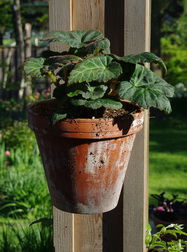 To take a much needed, pleasant break I am planting up an even bigger variety of containers. The soil in them is naturally warm and it is soft and easy to work with. I have discovered new packaged soils on the market. The soil producers have realized that we really don’t want to water every day and are producing more water retentive mixes for those of us who garden outdoors in containers and baskets. The one I tried last year seemed to make a difference and I have added another one to try this year. They have added compost and/or bentonite clay to help hold the water without compacting like garden soils do when used in a container. I kept the frugal gardener in the closet last winter and spent extra money buying bigger and better Begonia tubers. Money well spent. The new plants are already huge and dressing up the posts that contain my outdoor dining room and patio.
To take a much needed, pleasant break I am planting up an even bigger variety of containers. The soil in them is naturally warm and it is soft and easy to work with. I have discovered new packaged soils on the market. The soil producers have realized that we really don’t want to water every day and are producing more water retentive mixes for those of us who garden outdoors in containers and baskets. The one I tried last year seemed to make a difference and I have added another one to try this year. They have added compost and/or bentonite clay to help hold the water without compacting like garden soils do when used in a container. I kept the frugal gardener in the closet last winter and spent extra money buying bigger and better Begonia tubers. Money well spent. The new plants are already huge and dressing up the posts that contain my outdoor dining room and patio.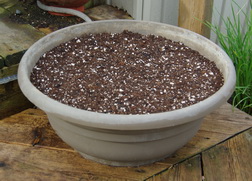 Many containers are too shallow to hold sufficient soil, even the new stuff, to allow us to water on a less frequent cycle. Look for deep containers that have a reservoir of soil. What do you do with all of those shallow containers. I have one that has a vary large surface area but is quite shallow. It is beside the kitchen door scattered with the seed of a Mesclun mix. The tiny leaves of lettuce, endive, mustard and the other assorted greens won’t ever make it to the bottom of this shallow planter and the large surface area should give me several pickings big enough for that night’s salad.
Many containers are too shallow to hold sufficient soil, even the new stuff, to allow us to water on a less frequent cycle. Look for deep containers that have a reservoir of soil. What do you do with all of those shallow containers. I have one that has a vary large surface area but is quite shallow. It is beside the kitchen door scattered with the seed of a Mesclun mix. The tiny leaves of lettuce, endive, mustard and the other assorted greens won’t ever make it to the bottom of this shallow planter and the large surface area should give me several pickings big enough for that night’s salad. 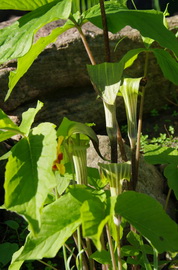 The real joy of walking around the garden early in the morning or later in the evening, is taking the time to rediscover and enjoy some of the small secrets that I have tucked away over the years. There are many small delightful plants that need a moment to be admired. Right now, up behind the Crab Apple tree, which is in full bloom and demanding attention, and beside the rock edge of the lower river is a small cluster of Arisaema. I know these quiet hooded flowers as “Jack in the Pulpit” and only by stopping to look can you appreciate the purple and white striped interior of the flowers. They are quite large but they also hide beneath the large tri-lobed leaves. Somehow they can be more exciting and rewarding than the showy tree that they are nestled under. Plant some of these and other novelties and you will often have to wait a year or two for them to establish and then they become delightful discoveries when they peek out from their protected places.
The real joy of walking around the garden early in the morning or later in the evening, is taking the time to rediscover and enjoy some of the small secrets that I have tucked away over the years. There are many small delightful plants that need a moment to be admired. Right now, up behind the Crab Apple tree, which is in full bloom and demanding attention, and beside the rock edge of the lower river is a small cluster of Arisaema. I know these quiet hooded flowers as “Jack in the Pulpit” and only by stopping to look can you appreciate the purple and white striped interior of the flowers. They are quite large but they also hide beneath the large tri-lobed leaves. Somehow they can be more exciting and rewarding than the showy tree that they are nestled under. Plant some of these and other novelties and you will often have to wait a year or two for them to establish and then they become delightful discoveries when they peek out from their protected places.The Nematodes arrived yesterday and were immediately released to wreak havoc upon the dreaded Iris borer. They worked very well last year and the number of Iris that are showing the beginnings of bloom stalks this year is causing great anticipation in this Iris lover’s heart. Last year the Assistant Gardener was in charge of distributing these wonderful predators as I was away when they arrived. She counted and measured and poured carefully and was a little taken aback at the somewhat more casual approach used this year. She was even more annoyed when the casual approach produced just the right number of watering cans filled with Nematodes to nicely do all of the Iris. Somedays I’m just lucky, I guess. These microscopic worms also can be used to do a great job controlling grubs in your lawn; something that is important to know as most of the chemical controls are wisely removed from the market. 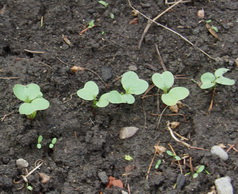 The mini - assistant gardener who is all of three years old needs to be introduced to the magic of gardening. He helped me plant some seeds on his last visit and like most children, doesn’t want to wait long for results. Get the mini - assistants to plant several things but always include radish. Here they are up and noticeable in less than a week and in 3 - 4 weeks they will be able to pull and enjoy them. Gardening, especially with vegetables, is a skill that should be slipped into every child’s experience when it is still a wonder to them. It is, of course, in my humble opinion, best done by patient and doting grandparents.
The mini - assistant gardener who is all of three years old needs to be introduced to the magic of gardening. He helped me plant some seeds on his last visit and like most children, doesn’t want to wait long for results. Get the mini - assistants to plant several things but always include radish. Here they are up and noticeable in less than a week and in 3 - 4 weeks they will be able to pull and enjoy them. Gardening, especially with vegetables, is a skill that should be slipped into every child’s experience when it is still a wonder to them. It is, of course, in my humble opinion, best done by patient and doting grandparents.Questions My newsletter subscribers get to ask me questions. Just ‘reply’ to the email newsletter. It is always interesting to read the questions; mostly to see if I actually can answer them or if I have to wade into the textbooks to research the answers. If that happens then we all learn something. Sandy Asks? Hi Ken, I’ve got a problem growing sweet peas what exposure do they like? I’ve put them in a south side of the house, and the west front of the house and they don`t seem to want to grow HELP PLEASE. Ken Answers! Sweet Peas should be happy with all of the sun that you have given them. They are peas, however and do not like very hot weather. If you have them close to the house where the sun will really warm them up, they may not perform as well. Keep them well watered to keep their roots from getting cooked and that should help. They are also somewhat slow to get going, as they spend some early days developing a healthy root system. Mine have hardly moved in the last week or two since I planted them but they should soon grab hold of the netting and start to run up it. 111 Trent St. W. Whitby ON L1N1L9 |
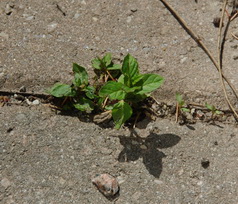 The tenacity of certain plants never ceases to amaze me. I always like to have some mint in my garden but am very aware of the need to keep it contained. Starting some new pieces in a container is probably the best way to organize these rampant but useful plants. That requires me to take some pieces in every fall and keep them growing indoors. It’s not a bad idea to have indoor herbs but it’s just another little job in the fall and most mint will really only survive, as opposed to thrive, during the winter. Mine is planted outside where I hoped it would never escape. The planting spot was between two rock walls and the hole was lined with rubber pond liner to a depth of at least 30 cm. The paving bricks in the picture are beside the rock and about 15 cm below. There is the wonderful mint, down, under, 20 cm through limestone screenings and then seizing upon a tiny crack between the bricks to reach the sunlight. Getting it out of there will be an equally daunting task. Maybe I should just kill the whole thing and go the container route. It is such an addition to salad dressings and grilled lamb.
The tenacity of certain plants never ceases to amaze me. I always like to have some mint in my garden but am very aware of the need to keep it contained. Starting some new pieces in a container is probably the best way to organize these rampant but useful plants. That requires me to take some pieces in every fall and keep them growing indoors. It’s not a bad idea to have indoor herbs but it’s just another little job in the fall and most mint will really only survive, as opposed to thrive, during the winter. Mine is planted outside where I hoped it would never escape. The planting spot was between two rock walls and the hole was lined with rubber pond liner to a depth of at least 30 cm. The paving bricks in the picture are beside the rock and about 15 cm below. There is the wonderful mint, down, under, 20 cm through limestone screenings and then seizing upon a tiny crack between the bricks to reach the sunlight. Getting it out of there will be an equally daunting task. Maybe I should just kill the whole thing and go the container route. It is such an addition to salad dressings and grilled lamb.